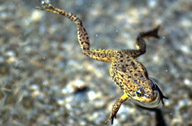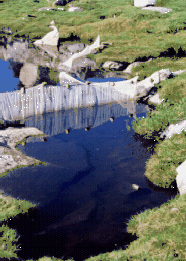Sierra Nature Notes, Volume 1, January 2001
The
Mountain Yellow-legged Frog -
Can They be Saved?
by Vance Vredenburg, Ph.D
Research Scientist, Museum of Vertebrate Zoology, Department of Integrative
Biology, University of California, Berkeley
Amphibians have been disappearing at an alarming rate all over the world, but not all species appear to be affected, even in the most ecologically stressed areas. Most alarming is that many extinctions and population crashes have occurred in habitats we thought protected. California has been no exception: amphibians, particularly frogs, have been declining even in our national parks, most notably Yosemite and Sequoia and Kings Canyon National Parks. In the high elevation areas of the Sierra Nevada Mountains there are three native frogs: the Yosemite Toad (Bufo canorus), the Mountain Yellow-legged Frog (Rana muscosa), and the Pacific tree frog (Hyla regilla). Of these, the Yosemite Toad is endangered, the Mountain Yellow-legged Frog has recently been proposed for endangered status, and the Pacific Tree Frog appears not to be affected and is very common.

|
Of 86 historic sites surveyed in the Sierra Nevada for the Mountain Yellow-legged Frog between 1915 and 1959, only 16 contained frogs when they were revisited between 1989 to 1995. Herpetologists studying the species estimate only about 10 percent of the MLF historic population still remains. As recently as 20 years ago, hikers strolling along the shores of Yosemite's alpine lakes would be charmed by the sight of literally hundreds of the Mountain Yellow-legged Frog leaping from a meadowy bank into the protection of the lake as campers approached. Today, most of these frogs are gone. "We're about to lose what was once the most common amphibian in the Sierra Nevada," said Jeff Miller with the Center for Biological Diversity.
The greatest threats to the mountain yellow-legged frog are:
Using field experiments I am testing two hypotheses for amphibian decline: the introduction of nonnative predators (fish), and the effects of UVB radiation on egg hatching success.
Fish &
Frogs
After the glaciers retreated from the Sierra 10,000 years ago, fish were never
able to populate almost all the alpine lakes of the range because waterfalls
and other obstacles blocked their path from the lowlands. When the first explorers
and tourist parties began arriving around the turn of the century, though,
they began to introduce fish to those high lakes - carrying them in milk cans
loaded on pack mules, then dumping the fish into all the lakes they could
reach. Later, this practice was carried on more systematically by the National
Park Service and the California Department of Fish and Game. Fish were still
being stocked in Yosemite and Sequoia Kings Lakes as recently as the early
80s. Stocking is still occurring in US Forest Service Wilderness area lakes.
Small fish raised in hatcheries are dropped from planes into even the most
remote lakes.
At present, the distribution of introduced trout and the remaining populations of Mountain Yellow-legged Frogs are strongly non-overlapping - that is, they rarely occur together. There are, though, a few cases where tadpoles, adult frogs and trout have been reported to coexist in the same habitat. Since 1996, my coworkers and I have been studying the relationship between fish and frogs in an alpine basin in Kings Canyon National Park. Beginning in late May and with the permission of the National Park Service, we set up camp in this basin at about 11,000 feet and spend the next 5 months surveying the lakes, tracking frogs with small radio transmitters and conducting experiments in the basin's 83 lakes and ponds.
Our survey found
only 8 lakes with both trout and the Mountain Yellow-legged Frog. Tadpole
numbers were significantly higher in lakes that did not contain any trout.
Of the 8 lakes with frogs and fish, only one had large numbers of frog larvae,
and it had only a few trout and no trout reproduction. As a result of this
work, I suggest that there is little if any stable coexistence between Rana
muscosa and introduced trout; apparent cases result from transient movements
of adults and subadults, or represent sink populations.
 |
| Fine mesh net separates frogs from fish: frogs won't lay eggs where there are fish, but will in the fish-free part. |
To test this hypothesis further, we conducted several experiments to test how frogs and fish coexisted. In the first test, we divided a small pond that we knew frogs laid eggs in into two parts, using a net. We then introduced fish on one side of that net. Afterwards, frogs would not lay eggs on the side that had the fish.
In another test, we trapped all the fish and removed them from two of the basin's lakes. Within weeks frogs began appearing and in the following year they laid eggs. They have continued a normal life cycle in the two years since the fish were eliminated.
Predator detection plays a key role in prey survival. In aquatic systems many amphibian larvae have developed the ability to detect predators by their sense of smell. In another study, I investigated the relationship between anti-predator behavior and the level of shared evolutionary history between predators and prey. I conducted a series of simple experiments to test whether tadpoles of mountain yellow-legged frogs displayed anti-predator behavior in the presence of chemical cues from predators.
Because of the receding glaciers, the Mountain Yellow-legged Frog evolved in completely fishless habitat in the Sierra Nevada. I tested the response of tadpoles and their reactions to trout. I also tested whether tadpoles displayed anti-predator behavior in the presence of chemical cues from predators with which they shared an evolutionary history: native garter snakes. My results show that evolutionary history does matter. Tadpoles showed no behavioral response to nonnative predators (trout), but a strong response to native predators (snakes). These experiments help explain why there is so little overlap between introduced trout and native frogs and points to the danger of continuing trout introduction programs in areas where fauna did not evolve with fish predation.
The Ozone
Hole and Frogs
The worldwide decrease in the earth's ozone layer has led to speculation that
the increased levels of Ultraviolet light let through as a result may be causing
genetic damage to frog eggs and contribute to their decline. In another experiment
I tested the effects of UVB radiation on egg hatching success. In 1998 and
1999 I conducted field exposures of R. muscosa and H. regilla
embryos to fractions of ambient UVB radiation at three different sites. The
initial good news is that I found no differences in hatching success among
the treatments. In 1999 I was able to include Yosemite Toads in the experiment
and also found no effect of UVB on hatching success.
Conclusions
The results of my research, added to that of other scientists working in the
Sierra, indicate that nonnative fish introduced only 100 years ago are responsible,
at least in part, for the rapid decline of the Mountain Yellow-legged Frog
in the National Parks and forests of the alpine Sierra Nevada. The significance
of these results are important to the conservation of the Mountain Yellow-legged
Frog in the Sierra Nevada, recently proposed as an endangered species, and
will be used to design future recovery efforts. To reverse population declines
of native mountain yellow-legged frogs in the high Sierra, land managers should
eliminate current fish planting efforts and should make plans to remove introduced
fish from areas still containing sensitive frog populations.
Information for this article was also provided by the Center for Biological Diversity and the Pacific Rivers Council.
For Further Reading:
SIERRA NEVADA NATURAL HISTORY - Storer and Usinger. Identifies and examines more than 740 plants and animals common to this area. The is the classic general field guide for all aspects of the natural history of the Sierra. 374 pp.
DISCOVERING SIERRA REPTILES AMPHIBIANS - Basey. This colorful book contains informative text illustrations and little-known facts about these lesser-known creatures.56 pp.
Web Links:
Press Release: Endangered
status for the Mountain Yellow-legged frog requested by environmental groups
and the Pacific Rivers Council.
Vance Vredenburg's Web Page
Amphibia Web Amphibia Web is
an online resource for people concerned with the declining amphibian problem:
"By providing easy access to data, we hope to accelerate broad-scale
understanding of the causes of amphibian declines."
Special thanks to Carlos Davidson and Tim C. Ziesmer for permission to use the recording of the Yellow-legged Frog and to AmphibiaWeb for providing it.
Our Founder Questions? Go to About Our New Site |
Masthead
Photo from: |